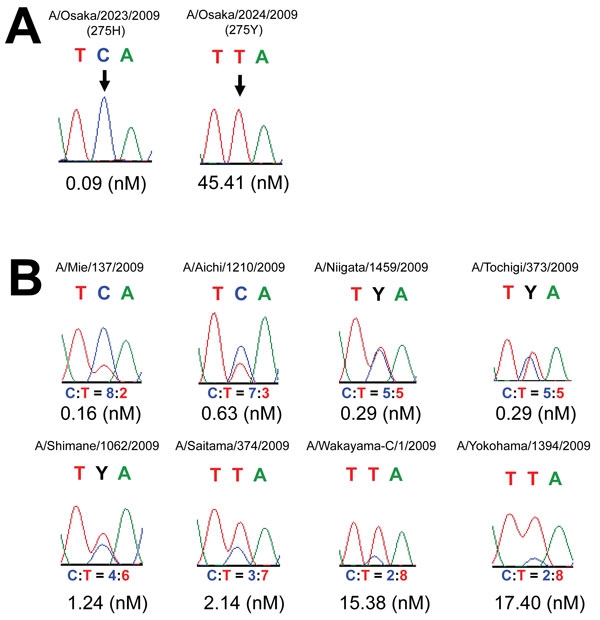Volume 17, Number 3—March 2011
Research
Monitoring and Characterization of Oseltamivir-Resistant Pandemic (H1N1) 2009 Virus, Japan, 2009–2010
Figure A1

Figure A1. The relationship between sequence wave patterns and 50% inhibitory concentration (IC50) values of representative oseltamivir-susceptible (OS) and oseltamivir-resistant (OR) pandemic (H1N1) 2009 viruses and mixed viruses. A) Neuraminidase (NA) sequences and IC50 values of OS- (A/OSAKA/2023/2009, 275H) and OR pandemic (H1N1) 2009 (A/OSAKA/2024/2009, 275Y). The codon TCA (amino acid H at position 275 in NA protein) of OS pandemic (H1N1) 2009 changed to TTA (Y) in OS pandemic (H1N1) 2009 (arrow). Almost all viruses tested showed a single wave pattern at this position. IC50 values and the C:T signal ratio are indicated below each sequence. B) NA sequences and IC50 values of representative mixed viruses. Several wave patterns were observed among mixed viruses. The IC50 value of mixed viruses that had a C:T signal ratio of 8:2–5:5 tended to be close to that of OS pandemic (H1N1) 2009 (range 0.16–0.63 nM), while the IC50 values of mixed viruses that had a C:T signal ratio of 2:8 tended to be close to that of OS pandemic (H1N1) 2009 (15.– 17.40 nM). The IC50 values of mixed viruses that had a C:T signal ratio of 4:6–3:7 tended to display middling IC50 values (range 1.24–2.14 nM). In most cases, the C:T signal ratios of mixed viruses were correlated with IC50 values.
1Members of the Influenza Virus Surveillance Group of Japan are listed at the end of this article.